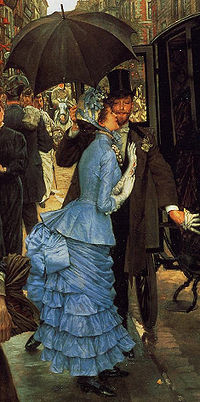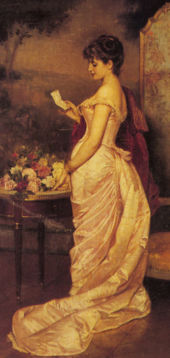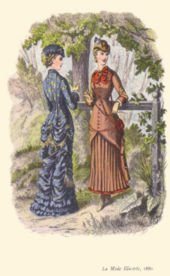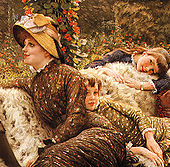
1880s in fashion
Encyclopedia

Europe
Europe is, by convention, one of the world's seven continents. Comprising the westernmost peninsula of Eurasia, Europe is generally 'divided' from Asia to its east by the watershed divides of the Ural and Caucasus Mountains, the Ural River, the Caspian and Black Seas, and the waterways connecting...
an and European-influenced countries is characterized by the return of the bustle
Bustle
A bustle is a type of framework used to expand the fullness or support the drapery of the back of a woman's dress, occurring predominantly in the mid-to-late 19th century. Bustles were worn under the skirt in the back, just below the waist, to keep the skirt from dragging. Heavy fabric tended to...
. The long, lean line of the 1870s
1870s in fashion
1870s fashion in European and European-influenced clothing is characterized by a gradual return to a narrow silhouette after the full-skirted fashions of the 1850s and 1860s.-Overview:...
was replaced by a full, curvy silhouette with gradually widening shoulders. Fashionable waists were low and tiny below a full, low bust supported by a corset
Corset
A corset is a garment worn to hold and shape the torso into a desired shape for aesthetic or medical purposes...
. The Rational Dress Society was founded in 1881 in reaction to the extremes of fashionable corsetry.
Women's fashion




Overview
As in the previous decade, emphasis remained on the back of the skirt, with fullness gradually rising from behind the knees to just below the waist. The fullness over the bottom was balanced by a fuller, lower chest, achieved by rigid corseting, creating an S-shaped silhouette.Skirts were looped, draped, or tied up in various ways, and worn over matching or contrasting underskirts. The polonaise
Polonaise (clothing)
A polonaise is a woman's garment of the later 1770s and 1780s or a similar revival style of the 1880s inspired by Polish national costume, consisting of a gown with a fitted bodice and cutaway, draped and poufed overskirt, worn over an underskirt or petticoat.The eighteenth century polonaise was a...
was a revival style based on a fashion of the 1780s, with a fitted, cutaway overdress caught up and draped over an underskirt. Long, jacket-like fitted bodices called basque
Basque (clothing)
A torsolette is a short corselette, covering the chest to the waist line.The undergarment is similar to a Victorian-era corset, but with less compression of the ribs. The modern-day Torsolette features lace-up or hook-and-eye fastening, as well as boning or vertical seams for structure and support...
s were also popular for daywear.
Evening gowns were sleeveless and low-necked (except for matrons), and were worn with long over the elbow or shoulder length gloves of fine kid leather or suede.
Choker
Choker
A choker is a close-fitting necklace, worn high on the neck. This type of jewellery can consist of one or more bands circling the neck. Chokers can be made of a variety of materials, including velvet, plastic, beads, metal, and leather. They are often adorned in a variety of ways, including with...
necklace
Necklace
A necklace is an article of jewellery which is worn around the neck. Necklaces are frequently formed from a metal jewellery chain. Others are woven or manufactured from cloth using string or twine....
s and jewelled collars
Collar (jewelry)
In jewelry, a collar is an ornament for the neck.Collar is an older word for necklace, and is usually reserved today for a necklace that lies flat to the body rather than hanging freely.Specifically, collar may refer to:...
were fashionable under the influence of Alexandra, Princess of Wales
Alexandra of Denmark
Alexandra of Denmark was the wife of Edward VII of the United Kingdom...
, who wore this fashion to disguise a scar on her neck.
Bodices were very tight fitted as a result of darts and princess seams. In the early 19th century dropped waists were common, creating a very long torso. Most ended in a point just below the waist. Collars that were very high and banded were very popular. These types of collars were called "officers collars".
Underwear
The bustleBustle
A bustle is a type of framework used to expand the fullness or support the drapery of the back of a woman's dress, occurring predominantly in the mid-to-late 19th century. Bustles were worn under the skirt in the back, just below the waist, to keep the skirt from dragging. Heavy fabric tended to...
returned to fashion and reached its greatest proportions ca. 1886–1888, extending almost straight out from the back waist to support a profusion of drapery, frills, swags, and ribbons. The fashionable corset created a low, full bust with little separation of the breasts.
The usual undergarment was a combination, a camisole
Camisole
A camisole is a sleeveless undergarment for women, normally extending to the waist. The camisole is usually made of satin, nylon, or cotton.- Historical definition :...
with attached knee- or calf-length drawers, worn under the corset, bustle, and petticoat. Woolen combinations were recommended for health, especially when engaging in fashionable sports such as riding or tennis.
Outerwear
Riding habitRiding habit
A riding habit is women's clothing for horseback riding.Since the mid-17th century, a formal habit for riding sidesaddle usually consisted of:* A tailored jacket with a long skirt to match* A tailored shirt or chemisette...
s had become a "uniform" of matching jacket and skirt worn with a high-collared shirt or chemisette
Chemisette
A Chemisette is an article of women's clothing worn to fill in the front and neckline of any garment. Chemisettes give the appearance of a blouse or shirt worn under the outer garment without adding bulk at the waist or upper arm.Chemisettes of linen or cotton were often worn with day dresses in...
, with a top hat
Top hat
A top hat, beaver hat, high hat silk hat, cylinder hat, chimney pot hat or stove pipe hat is a tall, flat-crowned, broad-brimmed hat, predominantly worn from the latter part of the 18th to the middle of the 20th century...
and veil. They were worn without bustles, but the cut of the jacket followed the silhouette of the day.
In contrast, hunting costumes were far more fashionably styled, with draped ankle-length skirts worn with boots or gaiters
Gaiters
Gaiters are garments worn over the shoe and lower pant leg, and used primarily as personal protective equipment; similar garments used primarily for display are spats....
.
Tailor
Tailor
A tailor is a person who makes, repairs, or alters clothing professionally, especially suits and men's clothing.Although the term dates to the thirteenth century, tailor took on its modern sense in the late eighteenth century, and now refers to makers of men's and women's suits, coats, trousers,...
ed costumes consisting of a long jacket and skirt were worn for travel or walking; these were worn with the bustle and a small hat or bonnet. Travelers wore long coats like dusters
Duster (clothing)
A duster is a light, loose-fitting long coat.The original dusters were full-length, light-colored canvas or linen coats worn by horsemen to protect their clothing from trail dust. These dusters were typically slit up the back to hip level for ease of wear on horseback and were the recommended...
to protect their clothes from dirt, rain, and soot.
Aesthetic dress
Artistic or Aesthetic dressArtistic Dress movement
The Artistic Dress movement and its successor, Aesthetic Dress, were fashion trends in nineteenth century clothing that rejected the highly structured and heavily trimmed Paris fashion of the day in favour of beautiful materials and simplicity of design....
remained an undercurrent in Bohemian circles throughout the 1880s. In reaction to the heavy drapery and rigid corseting of mainstream Paris fashion, aesthetic dress focused on beautiful fabrics made up simply, sometimes loosely fitted or with a belt at the waist. Aesthetic ideas influenced the tea gown
Tea gown
A tea gown or tea-gown is a woman's at-home dress for informal entertaining of the late 19th to mid-20th centuries characterized by unstructured lines and light fabrics. Early tea gowns were a European development influenced by Asian clothing, part of the japonism of Aesthetic dress...
, a frothy confection increasingly worn in the home, even to receive visitors.
Hairstyles and headgear
HairHair
Hair is a filamentous biomaterial, that grows from follicles found in the dermis. Found exclusively in mammals, hair is one of the defining characteristics of the mammalian class....
was usually pulled back at the sides and worn in a low knot or cluster of ringlets; later hair was swept up to the top of the head. Fringe or bangs remained fashionable throughout the decade, usually curled or frizzled over the forehead.
Bonnet
Bonnet (headgear)
Bonnets are a variety of headgear for both sexes, which have in common only the absence of a brim. Bonnet derives from the same word in French, where it originally indicated a type of material...
s resembled hat
Hat
A hat is a head covering. It can be worn for protection against the elements, for ceremonial or religious reasons, for safety, or as a fashion accessory. In the past, hats were an indicator of social status...
s except for their ribbons tied under the chin; both had curvy brims.
Style gallery 1880–1884
- Leona Barel of New Orleans wears a long, fitted jacket with three-quarter-length striped sleeves over a matching striped skirt. A nosegay of flowers is pinned at her waist, c.1880.
- A rather impracticable-looking tennis costume.
- Georgiana Burne-Jones wears a princess-line gown trimmed with ruched panels and ruffles, c. 1882
- August 1882 fashion plate shows the return of the bustle: the tight overdress is looped up behind.
- Whistler's Portrait of Lady Meux (1881–1882) shows the fashionable full bosom.
- Misses' Polonaise has fitted bodice with a low point in front. The front of the skirt is cutaway and the back is looped up after the fashion of 1780s. It is shown over a gored skirt with ruffles. Throughout the century, younger teenage girls ("misses" in fashion plates) wore their skirts just above their ankles.
- Bathing dresses of 1883 show fashionable rear fullness.
- The Empress of Austria in a riding habitRiding habitA riding habit is women's clothing for horseback riding.Since the mid-17th century, a formal habit for riding sidesaddle usually consisted of:* A tailored jacket with a long skirt to match* A tailored shirt or chemisette...
, 1884. Her habit has the fashionable corseted silhouette, with a simpler skirt suited for riding, tall shirt collar, and top hat.
Style gallery 1885–1889
- Two-piece dress of c. 1885 the "back shelf" bustle. The bodice is draped up at both sides and worn over a matching underskirt. Los Angeles County Museum of ArtLos Angeles County Museum of ArtThe Los Angeles County Museum of Art is an art museum in Los Angeles, California. It is located on Wilshire Boulevard along Museum Row in the Miracle Mile vicinity of Los Angeles, adjacent to the George C. Page Museum and La Brea Tar Pits....
, M.2007.211.34a-b. - Madame Paul Poirson wears the fashionable neckline of mid-decade, wide at the bust and narrower at the shoulder. Flowers trim her bodice, hair, and draped skirt, 1885.
- Pair of embroidered suede boots by F. Pinet, Paris, c. 1885. Los Angeles County Museum of Art, M.58.4a-b.
- Outfit which is both strongly influenced by menswear and bustled. Hair is upswept, with bangs. Elbow-length gloves meet the shorter sleeves.
- Hairstyle of 1887 is swept up into a knot, with the front hair curled and frizzled over the forehead.
- Fashions from La Mode Illustrée show dresses made of contrasting fabrics worn with "shelf" bustles and opera-length gloves, 1887.
- Fashions of 1888 feature full busts, large "shelf" bustles, and wide shoulders. Gloves reach the elbow or slightly above.
- Eleanora Iselin wears a high-necked black satin costume trimmed with beaded passementeriePassementeriePassementerie or passementarie is the art of making elaborate trimmings or edgings of applied braid, gold or silver cord, embroidery, colored silk, or beads for clothing or furnishings....
, 1888. - Vicomtesse De Montmorand wears an evening gown fastened in back, without a bustle, signalling the styles of the next decade. Her hair is twisted into a small knot on top of her head and is worn with a curly fringe or bangs, 1889.
Atypical high-fashion
- The 1880s idea of practical women's attire is seen in this poster showing Annie OakleyAnnie OakleyAnnie Oakley , born Phoebe Ann Mosey, was an American sharpshooter and exhibition shooter. Oakley's amazing talent and timely rise to fame led to a starring role in Buffalo Bill's Wild West show, which propelled her to become the first American female superstar.Oakley's most famous trick is perhaps...
wearing shorter skirts and a complete lack of a bustle (acceptable for poorer rural frontier women and/or paid public performers). - Japanese print showing two young ladies dressed according to the latest Western fashions of time — except that the colors and designs of the fabrics are to Japanese tastes.
Men's fashion
Coats, jackets, and trousers
Three piece suits, "ditto suitDitto suit
The ditto suit is an early precursor of the lounge suit but often had a coat more akin to a frock coat or morning coat. That the waistcoat and trousers were matching made the suit more informal than those with silk faced lapels worn with formal striped trousers.-External links:* on display at the...
s", consisting of a sack coat with matching waistcoat
Waistcoat
A waistcoat or vest is a sleeveless upper-body garment worn over a dress shirt and necktie and below a coat as a part of most men's formal wear, and as the third piece of the three-piece male business suit.-Characteristics and use:...
(U.S. vest) and trousers
Trousers
Trousers are an item of clothing worn on the lower part of the body from the waist to the ankles, covering both legs separately...
(called in the UK a "lounge suit") continued as an informal alternative to the contrasting frock coat
Frock coat
A frock coat is a man's coat characterised by knee-length skirts all around the base, popular during the Victorian and Edwardian periods. The double-breasted style is sometimes called a Prince Albert . The frock coat is a fitted, long-sleeved coat with a centre vent at the back, and some features...
, waistcoat and trousers.
The cutaway morning coat was still worn for formal day occasions in Europe and major cities elsewhere, with a dress shirt and an ascot tie
Ascot tie
An ascot tie, or ascot, is a narrow neckband with wide pointed wings, traditionally made of pale grey patterned silk. This wide, formal tie is usually patterned, folded over, and fastened with a stickpin or tie tack. It is usually reserved for wear with morning dress for formal daytime weddings and...
. The most formal evening dress
Evening dress
Evening dress may refer to:* White tie, the most formal civilian dress code in Western fashion* Black tie, a semi-formal dress code for evening events and social functions in Western fashion...
remained a dark tail coat and trousers with a dark waistcoat. Evening wear was worn with a white bow tie and a shirt with a winged collar.
In mid-decade, a more relaxed formal coat appeared: the dinner jacket or tuxedo, which featured a shawl collar with silk or satin facings, and one or two buttons. Dinner jackets were appropriate when "dressing for dinner" at home or at a men's club.
The Norfolk jacket
Norfolk jacket
A Norfolk jacket is a loose, belted, single-breasted jacket with box pleats on the back and front, with a belt or half-belt. The style was long popular for boys' jackets and suits, and is still used in some uniforms. It was originally designed as a shooting coat that did not bind when the elbow...
was popular for shooting and rugged outdoor pursuits. It was made of sturdy tweed or similar fabric and featured paired box pleats over the chest and back, with a fabric belt.
Full-length trousers
Trousers
Trousers are an item of clothing worn on the lower part of the body from the waist to the ankles, covering both legs separately...
were worn for most occasions; tweed or woollen breeches were worn for hunting and other outdoor pursuits.
Knee-length topcoat
Topcoat
Topcoat may refer to:*A lightweight overcoat*The guard hairs of an animal's fur*A transparent or translucent coat of paint applied over the underlying material as a sealer...
s, often with contrasting velvet or fur collars, and calf-length overcoat
Overcoat
An overcoat is a type of long coat intended to be worn as the outermost garment. Overcoats usually extend below the knee, but are sometimes mistakenly referred to as topcoats, which are short coats that end at or above the knees. Topcoats and overcoats together are known as outercoats...
s were worn in winter.
By the 1880s the majority of the working class, even shepherds adopted jackets and waistcoats in fustian and corduroy with corduroy trousers, giving up their smock frocks.
Shirts and neckties
Shirt collarsCollar (clothing)
In clothing, a collar is the part of a shirt, dress, coat or blouse that fastens around or frames the neck. Among clothing construction professionals, a collar is differentiated from other necklines such as revers and lapels, by being made from a separate piece of fabric, rather than a folded or...
were turned over or pressed into "wings". Dress shirts had stiff fronts, sometimes decorated with shirt stud
Shirt stud
A shirt stud is a decorative fastener that fits onto a buttonhole on the front of a pleated shirt, or onto the starched bib of a stiff-front shirt. Such shirts have special buttonholes solely for shirt studs....
s, and buttoned up the back.
The usual necktie
Necktie
A necktie is a long piece of cloth worn for decorative purposes around the neck or shoulders, resting under the shirt collar and knotted at the throat. Variants include the ascot tie, bow tie, bolo tie, and the clip-on tie. The modern necktie, ascot, and bow tie are descended from the cravat. Neck...
was the four-in-hand and or the newly fashionable Ascot tie
Ascot tie
An ascot tie, or ascot, is a narrow neckband with wide pointed wings, traditionally made of pale grey patterned silk. This wide, formal tie is usually patterned, folded over, and fastened with a stickpin or tie tack. It is usually reserved for wear with morning dress for formal daytime weddings and...
, made up as a neckband with wide wings attached and worn with a stickpin.
Narrow ribbon ties were tied in a bow, and white bowtie was correct with formal evening wear.
Accessories
As in the 1870s, top hatTop hat
A top hat, beaver hat, high hat silk hat, cylinder hat, chimney pot hat or stove pipe hat is a tall, flat-crowned, broad-brimmed hat, predominantly worn from the latter part of the 18th to the middle of the 20th century...
s remained a requirement for upper class formal wear; bowlers
Bowler hat
The bowler hat, also known as a coke hat, derby , billycock or bombin, is a hard felt hat with a rounded crown originally created in 1849 for the English soldier and politician Edward Coke, the younger brother of the 2nd Earl of Leicester...
and soft felt hats in a variety of shapes were worn for more casual occasions, and flat straw boaters
Boater (hat)
A boater is a kind of men's formal summer hat....
were worn for yachting and other nautical pastimes.
Shoe
Shoe
A shoe is an item of footwear intended to protect and comfort the human foot while doing various activities. Shoes are also used as an item of decoration. The design of shoes has varied enormously through time and from culture to culture, with appearance originally being tied to function...
s of the 1880s had higher heels and a narrow toe.
Style gallery
- British traveler wears a grey frock coat and matching trousers with a grey top hat, 1880. The coat has two covered buttons at the back waist.
- Painter John Singer Sargent wears a formally pleated Ascot tieAscot tieAn ascot tie, or ascot, is a narrow neckband with wide pointed wings, traditionally made of pale grey patterned silk. This wide, formal tie is usually patterned, folded over, and fastened with a stickpin or tie tack. It is usually reserved for wear with morning dress for formal daytime weddings and...
. His shirt collar has softly curled wings, c. 1880. - Hermann von Helmholtz wears a dark coat, waistcoat, and trousers with a stiff-fronted and stiff-collared shirt, German, 1881.
- Theodor Mommsen wears a narrow necktie tied in a bow with his dark suit, German, 1881.
- Vanity Fair sketch of agricultural scientist John Bennet LawesJohn Bennet LawesSir John Bennet Lawes, 1st Baronet FRS was an English entrepreneur and agricultural scientist. He founded an experimental farm at Rothamsted, where he developed a superphosphate that would mark the beginnings of the chemical fertilizer industry.John Bennet Lawes was born at Rothamsted in...
portrays him in walking clothes. His coat with a waist seam and skirts cutaway in a smooth curve is worn with matching trousers and collared waistcoat, 1882. - George Etiene Cartier wears a dark frock coat, a decorative double-breasted waistcoat and, and a narrow bow tie. Montreal, after 1882.
- Lawmen of Dodge City wear their coats with only the high top button fastened. Wyatt EarpWyatt EarpWyatt Berry Stapp Earp was an American gambler, investor, and law enforcement officer who served in several Western frontier towns. He was also at different times a farmer, teamster, bouncer, saloon-keeper, miner and boxing referee. However, he was never a drover or cowboy. He is most well known...
(front row, second from left) wears a 3-piece "ditto" suit with contrasting binding around the coat collar and lapel, 1883. - Composer Anton Rubenstein conducts in formal evening wear (dark coat, trousers, and waistcoat, white shirt and tie), 1887.
Children's fashion
Young girls wore dresses with round collars and sashes. Fashionable dresses had dropped waists. PinaforePinafore
A pinafore is a sleeveless garment worn as an apron.Pinafores may be worn by girls as a decorative garment and by both girls and women as a protective apron. A related term is pinafore dress, which is British English for what in American English is known as a jumper dress, i.e...
s were worn for work and play. When going out, especially in the winter, girls wore lots of layers to keep warm. A warm coat was worn with kid leather gloves. A muff hand warmer was worn over the gloves, so when the girl removed her hands her gloves would keep them warm. Just like ladies, all upper-class Victorian girls wore gloves when going out. A hat or bonnet was worn as well, along with long, knee-length button-up boots or shorter boots with gaitors to give the appearance of wearing long boots.
Older boys wore knee-length breeches and jackets with round-collared shirts.
See also
- Victorian fashionVictorian fashionVictorian fashion comprises the various fashions and trends in British culture that emerged and grew in province throughout the Victorian era and the reign of Queen Victoria, a period which would last from June 1837 to January 1901. Covering nearly two thirds of the 19th century, the 63 year reign...
- Victorian dress reformVictorian dress reformDuring the middle and late Victorian period, various reformers proposed, designed, and wore clothing supposedly more rational and comfortable than the fashions of the time. This was known as the dress reform or rational dress movement...
- Artistic Dress movementArtistic Dress movementThe Artistic Dress movement and its successor, Aesthetic Dress, were fashion trends in nineteenth century clothing that rejected the highly structured and heavily trimmed Paris fashion of the day in favour of beautiful materials and simplicity of design....
- Corset controversyCorset controversyThe corset controversy is an ensemble of letters and articles concerning the corset that appeared in newspapers and periodicals in the 19th century.-Introduction:...

